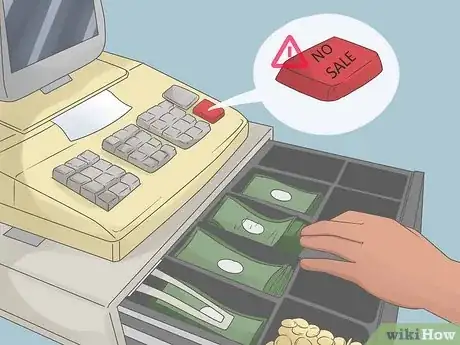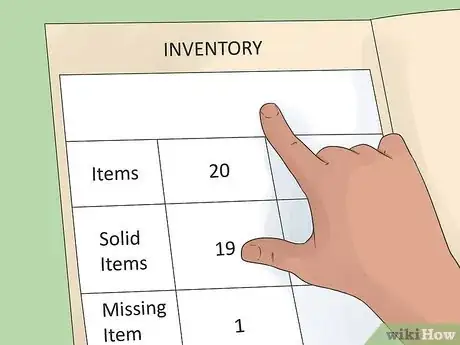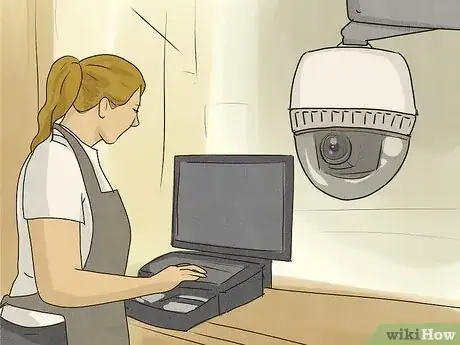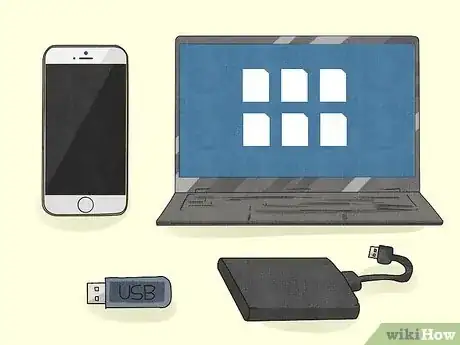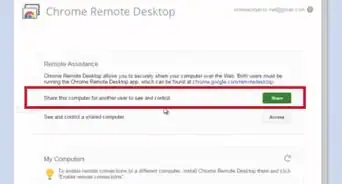This article was co-authored by Jeffrey Fermin and by wikiHow staff writer, Eric McClure. Jeffrey Fermin is a Performance Marketing Manager based in Miami, Florida, who currently works for AllVoices. He’s also the Founder of a full-service marketing company called New Theory. With over 10 years of experience, he specializes in digital marketing and content creation. He earned a Bachelor’s Degree in Psychology and a Bachelor of Education from Florida International University. Jeffrey has won a Microsoft Octas Innovation Award and is a TechCrunch Disrupt Runner-Up.
There are 15 references cited in this article, which can be found at the bottom of the page.
This article has been viewed 328,781 times.
If you suspect an employee is stealing, you may be wondering how to catch them. While there are a variety of measures you might use to catch a thief, you may need to rely on some deductive reasoning and clever guesswork. Once you’ve caught them, work with your company’s HR and legal departments to deal with the thief as you see fit. Here, we’ll break down how to spot thieves, what to do with them, and how you can prevent this issue in the future.
Things You Should Know
- Review your books, watch CCTV footage, and interview your employees to identify thieves in the workplace.
- Once you’ve caught a thief, consult human resources and your legal department to determine the next steps.
- Use your personal judgement to determine whether an employee can be rehabilitated, needs to be fired, or requires a report to law enforcement.
- As difficult as it can be to not take this personally, remember to be professional. The other employees will respect your candor if you handle this with poise.
Steps
Identifying Signs of Workplace Theft
-
1Note any missing inventory. Nothing should go missing without documentation to demonstrate what happened to it. If you find your goods are disappearing without any rhyme or reason, it’s a major sign that someone is stealing.[1]
- If you’re in an industry where spillage is common, like food service or hospitality, don’t presume that missing inventory is automatically theft.
-
2Look out for confusing receipts and anomalous transactions. Your sales and records should be relatively consistent. If you notice there are a lot of missing receipts, no sale receipts, or $0 sales during one particular employee’s shifts, then it could be a signal that a worker is stealing.[2]
- At the same time, this could simply be a sign they’re not well-trained on the register. If they’re new, consider doing additional training and see if the problem resolves itself.
Advertisement -
3Dig into the causes of any excessive voided or refunded receipts. Employees that steal cash from their register at work often use a set of related tactics to cover their tracks. These basically involve inputting certain functions into the cash register incorrectly, then using the opportunity to pocket some cash. Often, they’ll handle a cash transaction then enter a void or refund into the system.
- Edited printouts, excessive refunds, and missing transactions are all signs someone might be stealing.
- You could lock the refund button to require manager approval if this is a unique problem for you.
-
4Scan your books for unexplained drops in profits. Your books tell a story. If you notice that there’s a dramatic and unexplainable trend associated with a particular employee and your profits, it may be evidence that they’re skimming money off of the top.[3]
- This is unlikely to be theft if you’re tracking employee sales numbers. It’s much more likely that you simply have a few bad sales people who are underperforming.
-
5Go through the expense reports to look for questionable submissions. Expense reports are one of those things that companies don’t look at very closely, but falsified expense reports are a serious issue. If you notice one employee is expensing more than they should be based on other employee behavior or past history, go through their receipts to see if things don’t line up.[4]
- Requiring your employees to personally justify or get approval for business expenses is one simple way of preventing this.
Catching the Thief
-
1Review your books and reports carefully to spot inconsistencies. If you suspect someone has stolen from you, start by looking to see if there’s evidence in your records. Check your receipts, employee logs, and time cards to confirm that everything adds up. If you’re worried about missing products, go over your inventory and sales to see if everything lines up.[5]
- For example, let’s say your records show that you had 20 smartphones in stock at the start of the day and 10 in stock at the end of the day. If you only have receipts for 9 sales, it’s a major red flag.
-
2Scan the security footage to catch a thief red-handed. If your business has a video security system, check the footage to spot thefts. Even if you don’t catch the thief, you might at least rule out suspects. Look closely for telltale signs of thievery, including:[6]
- An employee's hands passing bills from a register into their pockets.
- Strange behavior or fidgeting around the register when nobody is around.
- Good merchandise going into the garbage or being moved where it doesn’t belong.
- Frequent “change making” between the tip jar and the register.
-
3Track the register balance yourself with each shift change. If you have a register at the workplace, perform the register changes yourself to confirm that the numbers match the receipts. This is the best way to catch a potential thief in the act, since the register will have much more cash than the receipts reflect if they actually are gaming the system and stealing.[7]
- When you do have register changes, require multiple employee signatures to sign off on the balance. That’s the easiest way to prevent thefts at register changes.
-
4Install tracking software on your registers and computers. There are plenty of companies out there who make software that track keystrokes and entries in your POS program.[8] If your employees have laptops or work remotely, you can have them install monitoring software to confirm they’re not stealing.[9]
- Popular tracking programs include SentryPC, Teramind, ActivTrak, and HubStaff.
-
5Hire a forensic accountant for complex thievery and embezzlement. If you’re worried about larger-scale theft or embezzlement, hire a consultant to audit your books. Forensic accountants are trained to spot accounting and record-keeping tricks that indicate something is going on with employee theft or accounting manipulation.[10]
- Forensic accountants will typically charge $300-500 per hour for this kind of work. It’s pricey, but if someone is stealing it’s likely worth it.
-
6Document time theft with video surveillance and employee check-ins. Time theft—where an employee steals the company’s time by refusing to complete their tasks—is extremely easy to document on camera. Simply scan the CCTV and monitor the employee’s behavior, or pop by periodically to see what they’re up to. If they aren’t behaving responsibly, sit them down to talk about their performance.[11]
- If you don’t have CCTV cameras installed, now is the time. Not only are they helpful in documenting potential customer issues and preventing thefts, but they’re a key part of keeping your employees accountable.
-
7Interview all your employees to see if anyone knows something. One by one, bring your employees into your office and sit them down for a chat. Be friendly, but politely ask if they’ve noticed any theft going on. Let them speak and try to gather as much information as possible. Use your intuition, the info you get, and deductive reasoning to determine who the thief is (if there is one).[12]
- Ask the employee if they mind you recording the conversation before you start.
- You might sit employees down and say, “We have a problem with someone stealing. Do you happen to know anything about it?”
- Note when the employee resists a follow-up question. Resistance, discomfort, and changing the subject are all signs that they know something.
Dealing with the Culprit
-
1Document everything and keep a paper trail to protect yourself. Your biggest friend when it comes to catching thieves in your workforce is evidence. Before you confront the thief, gather all of the information that helps you pinpoint when the theft occurred, who was involved, and what was taken.[13]
-
2Take all of the evidence to your HR department if you have one. If you are not the owner of the company, leave this up to HR. Take your evidence and documentation to human resources and/or the legal department. This is their job, so let them handle it.[14]
- If you don’t have an HR or legal department, take your evidence and info to your immediate higher-up and ask them what they’d like to do.
- What you do with an employee you caught stealing might be up to you, but you want to ensure that you’ve covered your bases before you do anything rash.
-
3Consult your state laws before you address or fire the thief. Even if the employee has been caught stealing, you may not be legally allowed to fire them right away. When you start suspecting an employee is stealing, consult an attorney or look up your local labor laws to see what the rules are here. You may need a certain threshold of evidence before you can legally let them go.[15]
- If you’re in an “at will” state and you have no contracts with your employees, you can typically fire anyone at any time without reason.
-
4Talk to the thief privately to avoid making a show out of this. Even if publicly firing or confronting the employee may encourage other employees to behave well going forward, you don’t want to make an example of someone at the expense of scaring anyone. A big show now will not pay off in the long run, so terminate or talk to the thief in private.[16]
- Bring HR and/or a legal department rep if you have these departments at your company.
- You might say, “Look, we’ve got evidence that you’ve been taking money out of the register. Do you have anything to say about this?”
-
5Contact law enforcement if the theft over $100. If you have direct evidence of a theft and the amount was more than $100, contact the police. Ask the employee to leave the building and meet with the cops to relay what happened and let them handle it.[17]
- Contacting police when you don’t have decent evidence that they actually stole something may get you in serious trouble with your other employees or the law.
-
6Terminate the employee if you no longer wish to employ them. After consulting HR and the legal department, you may feel firing the employee is appropriate. If so, go ahead and terminate them. Explain why they’re being let go and tell them to clear out their workspace immediately.[18]
- If you have any security on site, enlist them to help you escort the employee off of the premises.
-
7Forgive the employee if they didn’t steal much and this was a one-time thing. If the employee is a superstar, their theft was relatively minor, and you think they can potentially be trusted again, you can absolutely keep them on the team. Talk about what happened, explain the consequences of future mistakes, and work with them to prevent this from happening in the future.[19]
- This may be appropriate if the employee has been with you a long time and this is their first indiscretion, or if they’ve got personal issues (like financial problems) that have temporarily clouded their judgement.
- You might say, “I understand you’ve been going through a lot, and you seem genuine about being sorry. We’re going to let this go, but if you ever do this again, you’re out of here, okay?”
-
8Discuss the issue if it may have been a genuine mistake on their part. If an employee took some pens home or they “stole” from the tip jar without splitting it with coworkers or documenting the amount, they may have simply misunderstood the company policy. Talk these minor issues over to ensure it doesn’t happen again.[20]
- You might ask, “I saw you took cash home yesterday from the tip jar without cashing out the barbacks. Why did you do that?”
Theft-Proofing Your Business
-
1Set up an anonymous tip and feedback system. If you're trying to root out a few bad apples in your company, make it easy for your good employees to help you. Set up an anonymous feedback box or ask your employees to fill out an anonymous survey periodically. Employees will help weed out any coworkers who aren’t being honest with you.[21]
- This also gives employees a chance to voice their concerns, complaints, and provide constructive criticism in hopes of improving the workplace!
-
2Develop a personal relationship with each employee. Your employees are less likely to steal from you if they feel respected and cared for. While you may do a lot for your employees already, that personal touch can really make the difference to your team![22] You might try some of the following:
- Frequently talk to your employees informally about their lives, aspirations, and so on.
- Offer extra rewards and bonuses for outstanding work.
- Make an effort to talk with each employee individually at least a little.
- Consider organizing outside-of-work social activities (holiday parties, happy hour outings, etc.).
- Empathize with your employees' potential complaints and frustrations.
- Overall, try to create a culture of openness and transparency in your company.
-
3Adjust your workplace systems to make theft difficult. There are a handful of changes you may be able to make to minimize the amount of money or inventory that goes missing. Outside of the obvious things like changing security codes regularly and installing security cameras, try some of the following:[23]
- Use clear trash bags. Employees may hide merchandise in the trash, then stash it in a safe spot when they take the garbage out.
- Require all boxes to be flattened before recycling. This makes it harder to steal merchandise or hide inventory.
- Rearrange furniture or remodel to eliminate blind spots. Employees are less likely to steal when there are fewer spots where they can't be seen.
- Use random register audits/inspections. Play it up like you’re checking a mistake you made to avoid making employees feel like they’re being monitored.
- If applicable, use a POS (point of sale) system that tracks inventory and sales.
- Give occasional freebies and bonuses. Giving your employees unwanted merchandise or small bonuses go a long way to making them feel cared for.
Community Q&A
-
QuestionWhat do I do if my boss took cash that a customer paid and had me change the invoice to zero?
 Community AnswerContact a higher authority like a district manager. You may even be able to do so anonymously if you're worried about getting in trouble.
Community AnswerContact a higher authority like a district manager. You may even be able to do so anonymously if you're worried about getting in trouble. -
QuestionA pet-sitter I trusted never took the kitten to the vet, pocketed $400 and stole items in my home with his mother and friends. What can I do?
 Community AnswerTake it to other police. It's a crime. Give them all the information you have about him.
Community AnswerTake it to other police. It's a crime. Give them all the information you have about him. -
QuestionWhat is a good way to catch someone taking things out of the refrigerator at work?
 Community AnswerPlace bait. Put something you know they like in the refrigerator and stay hidden with a video camera to try and catch them in the act.
Community AnswerPlace bait. Put something you know they like in the refrigerator and stay hidden with a video camera to try and catch them in the act.
References
- ↑ https://xtrachef.com/wp-content/uploads/2021/01/xtraCHEF_How-to-Catch-Theft-and-Fraud-at-Your-Restaurant-1.pdf
- ↑ https://xtrachef.com/wp-content/uploads/2021/01/xtraCHEF_How-to-Catch-Theft-and-Fraud-at-Your-Restaurant-1.pdf
- ↑ https://www.forbes.com/sites/forbesbusinesscouncil/2019/10/24/how-to-prevent-your-employees-from-stealing-at-work/
- ↑ https://www.nytimes.com/2010/11/16/business/16expenses.html
- ↑ https://www.pmq.com/what-to-do-when-you-catch-a-pizzeria-employee-stealing/
- ↑ https://www.marchnetworks.com/intelligent-ip-video-blog/employee-theft-what-are-you-missing/
- ↑ https://xtrachef.com/wp-content/uploads/2021/01/xtraCHEF_How-to-Catch-Theft-and-Fraud-at-Your-Restaurant-1.pdf
- ↑ https://xtrachef.com/wp-content/uploads/2021/01/xtraCHEF_How-to-Catch-Theft-and-Fraud-at-Your-Restaurant-1.pdf
- ↑ https://www.techrepublic.com/article/employee-monitoring-software/
- ↑ https://www.eidebailly.com/insights/articles/2019/4/why-you-need-to-understand-the-importance-of-forensic-accounting
- ↑ https://www.forbes.com/sites/lizryan/2015/02/24/what-is-theft-of-time-and-what-does-it-mean-to-me/
- ↑ https://www.inc.com/magazine/19820601/6942.html
- ↑ https://www.inc.com/magazine/19820601/6942.html
- ↑ https://hrdailyadvisor.blr.com/2010/10/21/practical-steps-for-addressing-theft-in-the-workplace/
- ↑ https://www.usa.gov/labor-laws
- ↑ https://www.pmq.com/what-to-do-when-you-catch-a-pizzeria-employee-stealing/
- ↑ https://smallbiztrends.com/2019/09/employee-theft.html
- ↑ https://smallbiztrends.com/2019/09/employee-theft.html
- ↑ https://www.pmq.com/what-to-do-when-you-catch-a-pizzeria-employee-stealing/
- ↑ https://smallbiztrends.com/2019/09/employee-theft.html
- ↑ https://www.forbes.com/sites/forbeshumanresourcescouncil/2021/07/12/five-reasons-your-organization-needs-an-anonymous-employee-feedback-program/?sh=7f4bc508cf19
- ↑ https://hbr.org/2019/07/to-be-happier-at-work-invest-more-in-your-relationships
- ↑ https://www.forbes.com/sites/forbesbusinesscouncil/2019/10/24/how-to-prevent-your-employees-from-stealing-at-work/?sh=6bd3093e39b7
About This Article
If you suspect someone at work is stealing, there are things you can do to catch them and end workplace theft. As soon as you notice that a theft has happened, gather as much information as possible, including the time, date, what was stolen, and who was working at the time. You can also look for inconsistencies in inventory or sales records or note special register functions that would allow an employee to pocket some cash. If your business has a security camera, examine the footage for evidence of stealing, like strange behavior around merchandise or registers. While the thief may not admit what they’ve done, holding one-on-one interviews with all of your employees may lead to information that will point you in the right direction. To learn how to confront a stealing employee, keep reading!







